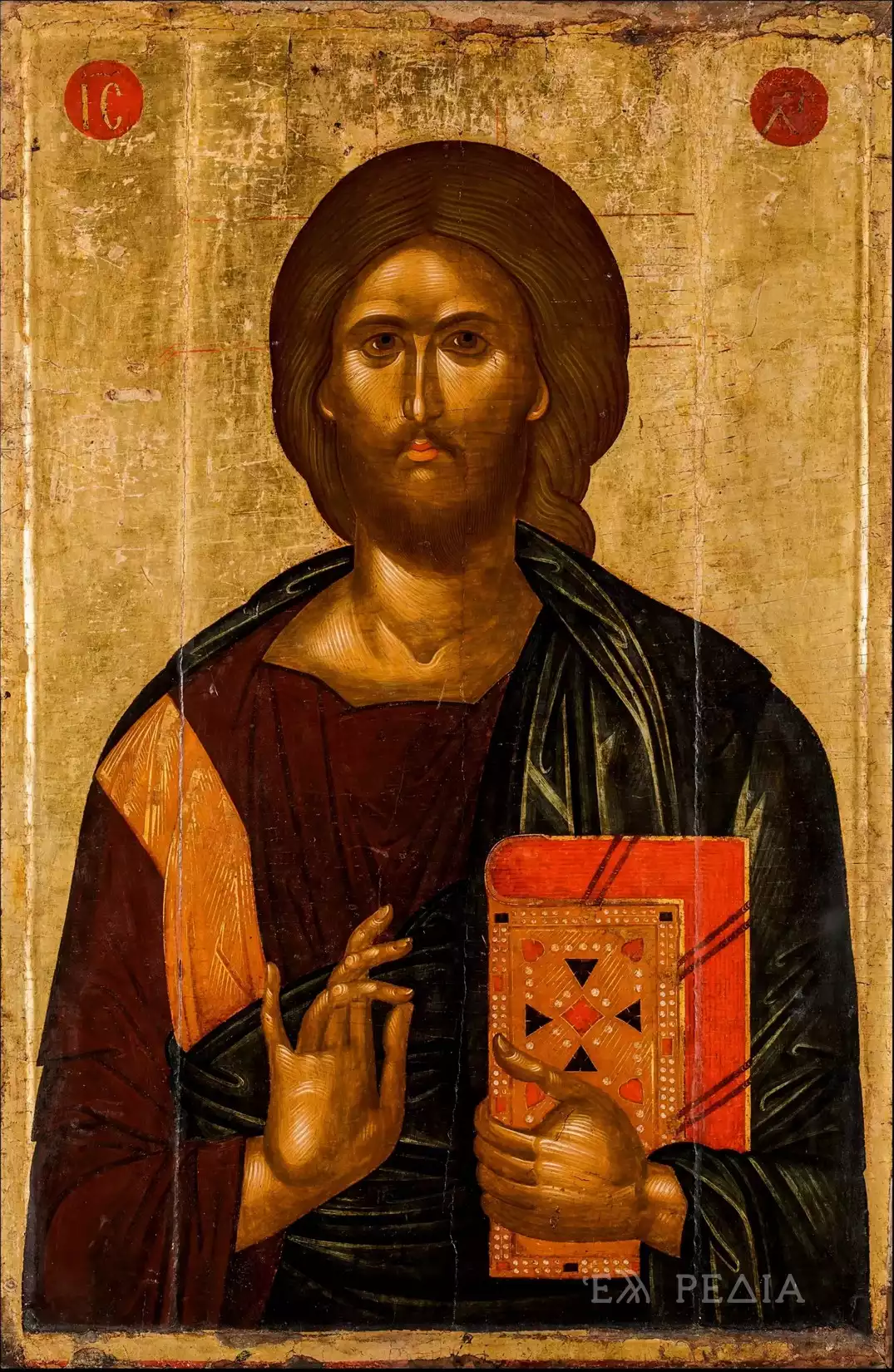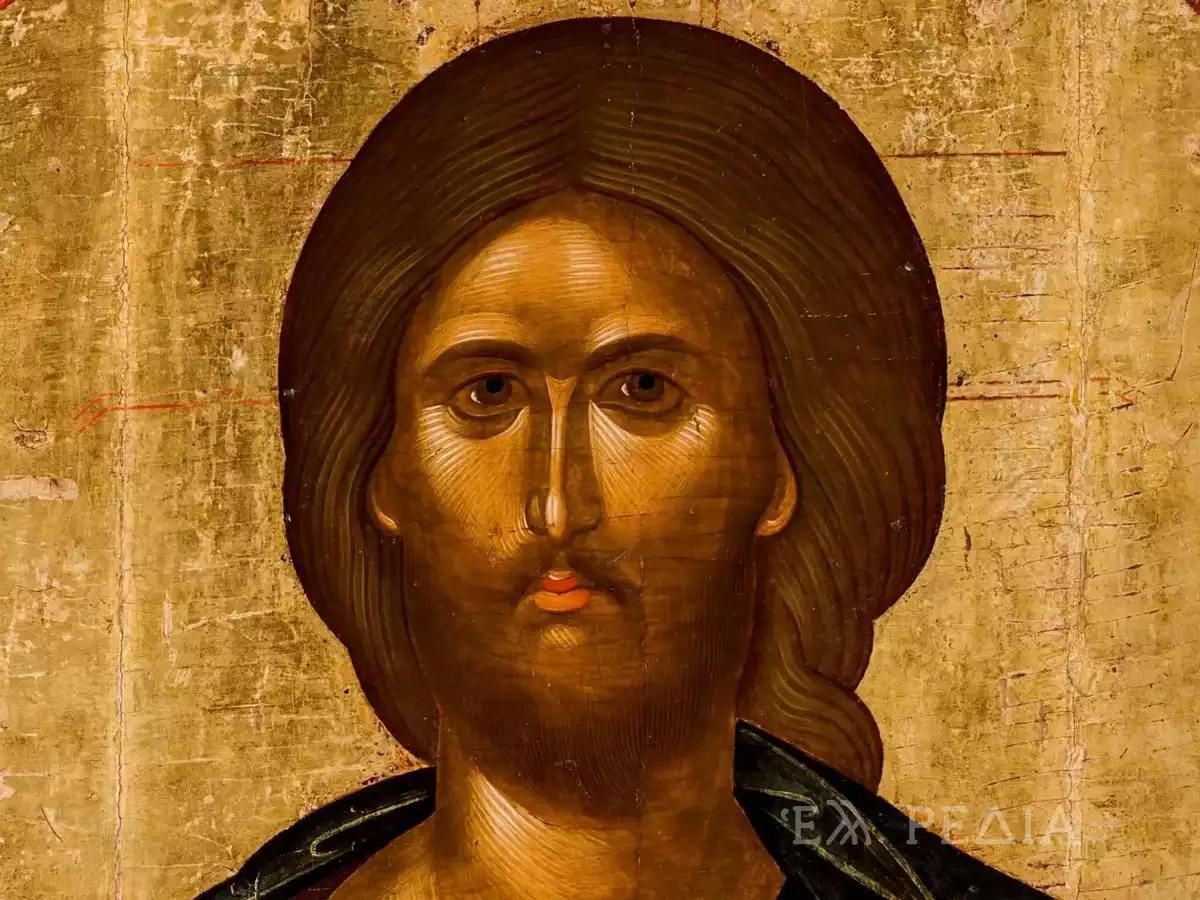
Title: Christ Pantokrator
Artist Name: Angelos Akotantos
Genre: Byzantine Icon
Date: 15th century AD
Dimensions: 89 x 57 cm
Materials: Egg tempera and gold leaf on wood
Location: State Museum of Fine Arts Pushkin, Moscow
The Pantokrator of Akotantos is one of the most significant examples of the Cretan School of iconography of the 15th century. The icon, which was crafted with exceptional mastery and theological precision, captures the form of Christ Pantokrator in a composition that combines spiritual power with divine serenity.
The use of a gold background creates a sense of transcendence, while the detailed rendering of Christ’s facial features reveals Akotantos’ high technical skill. The gaze of the Pantokrator, penetrating yet full of mercy, captivates the viewer, creating an immediate spiritual connection. The right hand is raised in blessing, while the left holds the decorated Gospel, symbols of divine teaching and authority.
The garments of Christ, with the carefully studied color combinations of deep red and blue, are rendered with exceptional plasticity and solemnity. The egg tempera technique allows for the creation of subtle gradations and chiaroscuro that give volume and vibrancy to the form.
Technique and Artistic Execution in the Pantokrator of Akotantos
The image of the Pantokrator by Angelos Akotantos is an exquisite example of the Cretan School of the 15th century, where technical perfection meets spiritual depth. The use of egg tempera combined with gold leaf on a wooden surface creates a composition of exceptional quality and durability over time.
The colors chosen for Christ’s garments – the deep red and blue – create a harmonious contrast that enhances the grandeur of the form. The detailed treatment of the drapery highlights a deep knowledge of anatomy and volume, while the careful gradation of tones gives a sense of naturalness to the transcendent presence of the Pantokrator.
A particular technique is evident in the rendering of the face, where Akotantos demonstrates exceptional skill in shaping the features (Mastrotheodoros). The skillful use of chiaroscuro creates an impressive sense of depth and intensity in Christ’s gaze, while the subtle gradation of color tones in the flesh gives liveliness and naturalness to the form.
The golden surface of the background, which is a characteristic element of Byzantine iconography, has been processed with exceptional care to create the sense of divine light. The technical application of gold leaf and the fine treatment of its surface create an effect that changes according to the surrounding light, giving the image a dynamic presence in space.
The Gospel that Christ holds in his left hand presents exceptional detail in its decoration, with intricate geometric patterns and a cross that highlight the artist’s skill in rendering details. The gesture of blessing with the right hand is executed with precision and grace, creating a balanced composition with the Gospel.
In the work, the merging of traditional Byzantine technique with modern elements of the Cretan School is evident, such as the increased plasticity in the rendering of volumes and the finer treatment of color transitions. This composition of traditional and innovative elements makes the Pantokrator of Akotantos a landmark work of post-Byzantine art.
Theological Symbolism and Iconography in the Pantokrator
In the iconographic tradition of the Orthodox Church, the depiction of the Pantokrator holds a prominent place, as it represents the supreme expression of divine presence. Akotantos’ work uniquely incorporates traditional iconographic elements with a personal artistic vision.
The central position of Christ in the composition emphasizes His omnipotence, while the frontal stance and penetrating gaze create an immediate relationship with the faithful. The gesture of blessing with the right hand symbolizes divine grace and protection, as the fingers form the initials IC XC, the monograms of the name of Jesus Christ in Greek.
On a spiritual level, the image serves as a bridge between the heavenly and earthly realms, where the gold background represents the uncreated light of divinity and the heavenly kingdom, while the symbols of authority, such as the Gospel and the gesture of blessing, underscore divine sovereignty (Trompf).
The Gospel that Christ holds in His left hand, decorated with precious stones and a cross, symbolizes the word of God and the teaching of the Church. The rich decoration of the book with geometric patterns and the cross at the center of the cover emphasizes its significance as a bearer of divine truth and wisdom.
The color palette of the Pantokrator’s garments – the combination of the deep red robe with the dark blue mantle – also carries deep theological significance: the red symbolizes the divine nature, while the blue represents the human, highlighting the doctrine of the dual nature of Christ in the one person of the God-Man.
The expression of the Pantokrator’s face masterfully combines the severity of the judge with the compassion of the savior, creating a balance that reflects God’s dual relationship with humanity. The large, expressive eyes, the straight nose, and the well-formed mouth compose a figure that inspires awe and simultaneously invites spiritual communication.

Historical Context of the Cretan School
The 15th century in Crete was a period of exceptional artistic flourishing. Under Venetian rule, the island evolved into a significant center for the production of icons, with the workshops of Chandaka (modern Heraklion) gaining fame throughout the Mediterranean.
This period is characterized by a fruitful meeting of Byzantine tradition with Western influences, creating a unique artistic expression. The Cretan artists developed a distinctive style that combined the spirituality of the East with the technical perfection of the West (Vassilaki).
Within this cultural environment, Angelos Akotantos emerged as one of the most significant figures of the Cretan School. His workshop in Chandaka became a center of artistic production, where traditional iconography met innovative technical approaches and high artistic quality.
The era was marked by intense commercial activity in the field of iconography, with Cretan icons gaining great demand both in the West and the East. The island’s workshops had developed a production system that combined artistic excellence with the ability to meet the demands of an expanded market.
The social status of painters in Cretan society was particularly notable. Artists often organized into guilds, maintaining high standards in their art and passing on their knowledge to the next generations. Apprenticeship under an established painter was the main way to educate new artists.
The presence of the Pantokrator of Akotantos in the Pushkin Museum in Moscow reflects the international appeal of Cretan art and its significance in the evolution of post-Byzantine painting. The work serves as a unique testimony to the artistic maturity achieved in Crete during the 15th century.
Legacy and Influence of the Pantokrator in Art
The image of the Pantokrator by Akotantos is not merely an isolated masterpiece, but a work that has left a profound imprint on the evolution of post-Byzantine art. The influence of the work extends beyond the geographical boundaries of Crete, shaping standards that affected later artists throughout the Orthodox world.
The technical perfection in execution, the delicate balance between tradition and innovation, and the spiritual power of the work established new standards in iconographic art. The way Akotantos handled egg tempera and gold leaf on wooden surfaces created a new painting language that combined spirituality with technical excellence.
The presence of the work in the Pushkin Museum in Moscow underscores the international recognition of Cretan art and its significance in the evolution of Orthodox iconography. Through this work, the Cretan School established its position as a center of artistic excellence, influencing the evolution of iconographic art throughout the Mediterranean.
The unique composition of the Pantokrator’s face, with its intense spirituality and technical perfection, set new standards in the depiction of the divine form. The delicate balance between severity and compassion in Christ’s expression served as a model for many later artists.
Akotantos’ innovative approach to the use of color and light profoundly influenced the evolution of technique in iconography. The method of rendering drapery and managing the color palette created a new aesthetic language that influenced generations of artists.
The preservation of the work in excellent condition to this day demonstrates the high quality of the materials and techniques used, making it a timeless example of artistic excellence. Its survival through the centuries has allowed for the continuous study and understanding of the techniques of the Cretan School.
The Timeless Value of the Pantokrator of Akotantos
The Pantokrator of Akotantos remains one of the most important works of the Cretan School, reflecting the artistic maturity and spiritual depth of its time. The image uniquely combines technical perfection with theological precision, creating a work that continues to move and inspire.
The presence of the work in the Pushkin Museum is a testament to the international scope of Cretan art and its significance in the evolution of Orthodox iconography. Its preservation in excellent condition allows for the continuous study and understanding of the techniques of the Cretan School.
The artistic legacy of Akotantos, as captured in the Pantokrator, continues to influence contemporary iconography, demonstrating the timeless value of the principles and techniques of the Cretan School. The work remains a timeless example of the ability of art to convey spiritual messages through artistic excellence.
elpedia.gr
Bibliography
Trompf, GW. “From the Ancient Near East to Christian Byzantium: Kings, Symbols, and Cities.” Journal of Religious History, 2023.
Mastrotheodoros, GP, M Theodosis, E Filippaki. “By the hand of Angelos? Analytical investigation of a remarkable 15th century Cretan icon.” Heritage, 2020.
Vassilaki, M. “The painter Angelos and icon-painting in Venetian Crete.” 2023.
